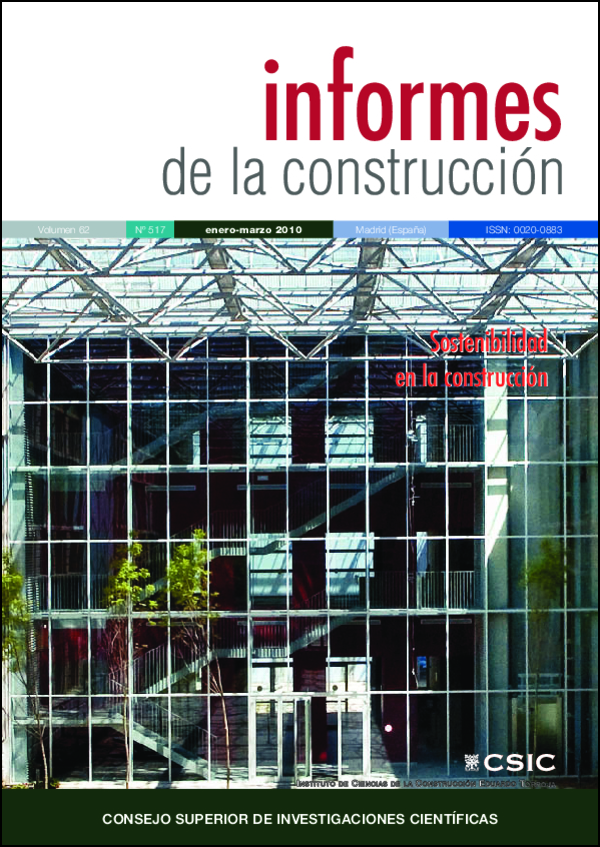Legal aspects about construction and demolition waste (CDW) in Spain. The Autonomus Region of Madrid
DOI:
https://doi.org/10.3989/ic.08.059Keywords:
waste management, construction and demolition waste (CDW), demolition, recycled materials, materials reutilization, sustainable growthAbstract
Spain is the fifth country in Europe generating construction and demolition waste (CDW) and unfortunately, it is one which does the least to recuperate it, as stated in the Symonds & Ass report. This report indicates that 90% of the 13 million tons of yearly generated waste materials end up in the dump and only 5% is recycled. In our country the management of CDW depends from the Autonomous Regions with the exception of the waste originated from minor house works; therefore, the Autonomous Regions have defined their management CDW plans referring to the National Plans. Those plans have been set based on the hierarchical principle, stated in title 1.1 of the 10/1998 Law referring to waste products. This principle establishes prevention as a top priority -whenever possible- followed by reutilization and recycling and in addition, to clearly assess all that cannot be reused o recycled. The final deposit in the dump is the last option, and the least satisfactory one. In this paper, some noticeable legal actions promoted in the last years by the Autonomous Region of Madrid to improve the management of CDW in buildings are presented.
Downloads
References
(1) Orden MAM/304/2002, de 8 de Febrero, por la que se publican las operaciones de valorización y eliminación de residuos y la lista europea de residuos. BOE 43, de 19-02-02
(2) Catálogo de residuos utilizables en la construcción (Cedex). Julio 2001. Demolición y reutilización de estructuras de hormigón. Recomendaciones y Manuales Técnicos Estructuras y edificación (E-7). Colegio de Ingenieros de Caminos y Puertos de Madrid. Hannecuart, Jean Pierre. “Guía de Buenas Prácticas para el reciclaje de los residuos plásticos. Una guía por y para las autoridades locales y regionales”. ACRR 2004. I Conferencia Nacional sobre Prevención de Residuos. Madrid. 5 y 6 de Abril de 2006. Ministerio de Medio Ambiente. Manual de directrices para el uso de áridos reciclados en obras públicas de la Comunidad Autónoma del País Vasco. Gobierno Vasco 2009. Floriach Puig, T. “La problemática de la gestión de los residuos de construcción, una aproximación al estado actual de la cuestión”. BIA. Colegio Oficial de Aparejadores y Arq. Técnicos de Madrid. 2008.
(3) I Plan Nacional de Residuos de Construcción y Demolición (2001-2006). Resolución de 14 de junio de 2001, de la Secretaría General de Medio Ambiente, por la que se dispone la publicación del Acuerdo de Consejo de Ministros, de 1 de junio de 2001
(4) Ley 42/1975. 19 de noviembre sobre Desechos y Residuos Sólidos Urbanos. BOE 280, 21-11-75.
(5) Plan Nacional Integrado de Residuos para el período 2008-2015. II Plan Nacional de Residuos de Construcción y Demolición (2007-2015). Resolución de 20 de enero de 2009, de la Secretaría de Estado de Cambio Climático.
(6) Real Decreto 105/2008, de 1 de febrero, por el que se regula la producción y gestión de los residuos de construcción y demolición. BOE 38.
(7) Plan de gestión de RCD. Comunidad autónoma de Madrid. (2002-2011).
(8) Real Decreto 1481/2001, de 27 de diciembre, por el que se regula la eliminación de residuos mediante depósito en vertedero. BOE: 25 de 29/1/2002.
Downloads
Published
How to Cite
Issue
Section
License
Copyright (c) 2010 Consejo Superior de Investigaciones Científicas (CSIC)

This work is licensed under a Creative Commons Attribution 4.0 International License.
© CSIC. Manuscripts published in both the print and online versions of this journal are the property of the Consejo Superior de Investigaciones Científicas, and quoting this source is a requirement for any partial or full reproduction.
All contents of this electronic edition, except where otherwise noted, are distributed under a Creative Commons Attribution 4.0 International (CC BY 4.0) licence. You may read the basic information and the legal text of the licence. The indication of the CC BY 4.0 licence must be expressly stated in this way when necessary.
Self-archiving in repositories, personal webpages or similar, of any version other than the final version of the work produced by the publisher, is not allowed.















